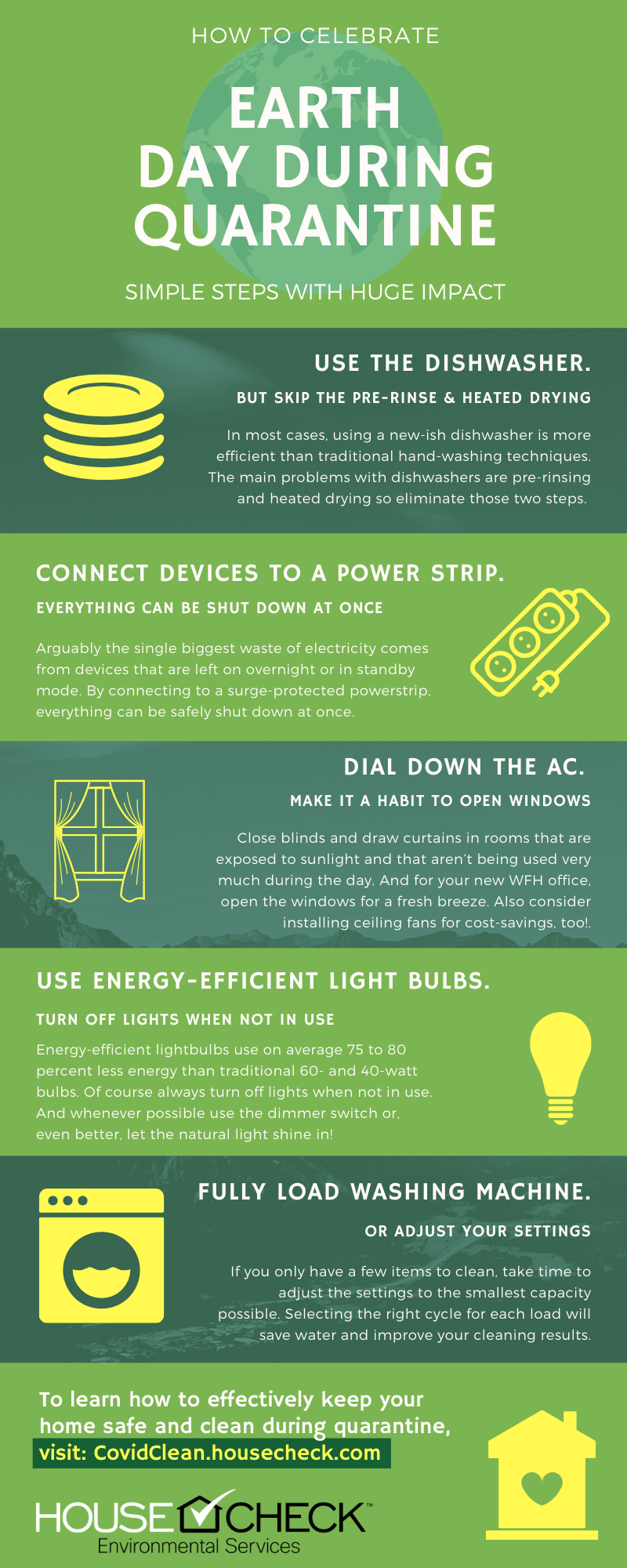While Earth Day is officially April 22, it’s a global event we should be “celebrating” all year long. During this COVID-19 pandemic, residents across the US and abroad, have been instructed to stay home.
And while there’s evidence that a reduced amount of carbon dioxide emissions might actually result from the quarantine, since the number of cars on the road has significantly decreased, it also means that other sources of pollution might rise because of the increased use of basic domestic resources like water and electricity.
However, this doesn’t mean there aren’t measures we can take in an attempt to reduce the amount of energy we use while sheltering in place. Here are five tips to help reduce your carbon footprint while celebrating Earth Day. Oh and save some money, too!

1) USE THE DISHWASHER
With so many of us cooking A LOT lately, the natural reaction is to “just put it in the dishwasher.” But is that really the most energy-efficient solution? The answer is: “usually.” The key here is using a new-ish dishwasher — they have proven to be more efficient than traditional hand-washing techniques.
In a recent study by The Journal of Environmental Research Communications they found the main problems with dishwashers are pre-rinsing and heated drying. Eliminating those two steps from your dish-washing routine decreases the appliance’s greenhouse gas emissions by 3 percent and 11 percent, respectively.
And when it comes to water use, the difference between manual and machine practices was even starker: Hand-washers used 34,200 gallons of water to a dishwasher’s 16,300 gallons over 10 years.
2) DIAL-DOWN THE AC
The AC is almost certainly the reason why electricity bills skyrocket during the summer. However, there are others ways to help keep your house or apartment cool. Especially now, before the summer heat strikes most states across the country.
Close blinds and draw curtains in rooms that are exposed to sunlight and that aren’t being used very much during the day. When the temperature is a little lower, early in the mornings and sometimes in the evening, open a few windows. The cross ventilation helps cool the home and the fresh air is a welcome during quarantine.
Also consider installing ceiling fans. It will effectively keep you cool on hot days while using significantly less energy. A 2.5-ton central air conditioner uses about 3,500 watts and a window A/C unit typically uses between 500 to 1,500 watts. In comparison, a ceiling fan uses only 15 to 95 watts depending on its size and speed. That’s a whopping 99% decrease in cooling costs when you use ceiling fans instead of air conditioners.
3) USE POWERSTRIPS
Arguably the single biggest waste of electricity comes from devices that are left on overnight or in standby mode; most typically, TVs and computers/laptops. Powering down all of these can be a pain and often overlooked.
By connecting the TV and any peripheral devices to a quality, surge-protected powerstrip, everything can be safely shut down at once. Similarly, the same is true for any desktop or laptop and linked external drives. The key here is making sure the powerstrip is accessible.
According to an interview by Forbes, environmental scientist Phil Ritz adds “(Powerstrips) reduce some of the vampire energy use that your computer’s using. And that’s a fairly big thing. If we all have just a simple power strip, it reduces the energy draw at night when we’re not using our computers.”
4) USE ENERGY-EFFICIENT LIGHT BULBS
Opting for energy efficient light bulbs is a tip that’s been around for a while but it’s definitely worth adding to the list. The energy and even cost savings are significant. Two options are available: compact fluorescent lightbulbs (CFLs) which are, in essence, just curly versions of the long tube fluorescent lights you may already have in a kitchen or garage. Or you can choose light-emitting diode bulbs (LEDs.)
We prefer LEDs over a typical CFLs because they last longer and can be used with a dimmer switch. Both CFLs and LEDs use 75 to 80 percent less energy than traditional 60- and 40-watt bulb, and can save you $60 to $125 dollars per bulb in energy costs over their life.
5) FULLY LOAD WASHING MACHINE
One of the largest uses of water in American households is laundry. Nearly 22% of household water usage is consumed just to do the laundry. And that was before the COVID-19 pandemic. Now, with a full house 24/7, and laundry piling up, we’re finding ourselves partially living in the laundry room.
Washing a full load of laundry is the most water-efficient choice. If you only have a few items to clean, take time to adjust the settings to the smallest capacity possible. Selecting the right cycle for each load will save water and improve your cleaning results. And, unless you have a specific situation, for example, handling laundry of a sick family member at home, skip the extra rinse cycle on your washer. If you are using the correct amount of detergent and loading the washer properly, you don’t need it. Another water saving strategy is to pre-treat stains correctly to avoid having to rewash clothing.
While we are all doing our part to stay home and stop the spread of coronavirus, let’s also remember to be kind to Mother Earth. Follow these 5 tips to reduce your carbon footprint while celebrating Earth Day. Oh, and in many cases save money, too. And for science-based tips to help keep your home clean and free of COVID-19, visit CovidClean.HouseCheck.com.
Sources:
https://covidclean.housecheck.com/?af=E9112321
https://20somethingfinance.com/cost-of-air-conditioning-vs-a-fan/
https://www.energy.gov/energysaver/save-electricity-and-fuel/lighting-choices-save-you-money
https://www.thespruce.com/save-water-in-the-laundry-room-2146003


Leave A Comment